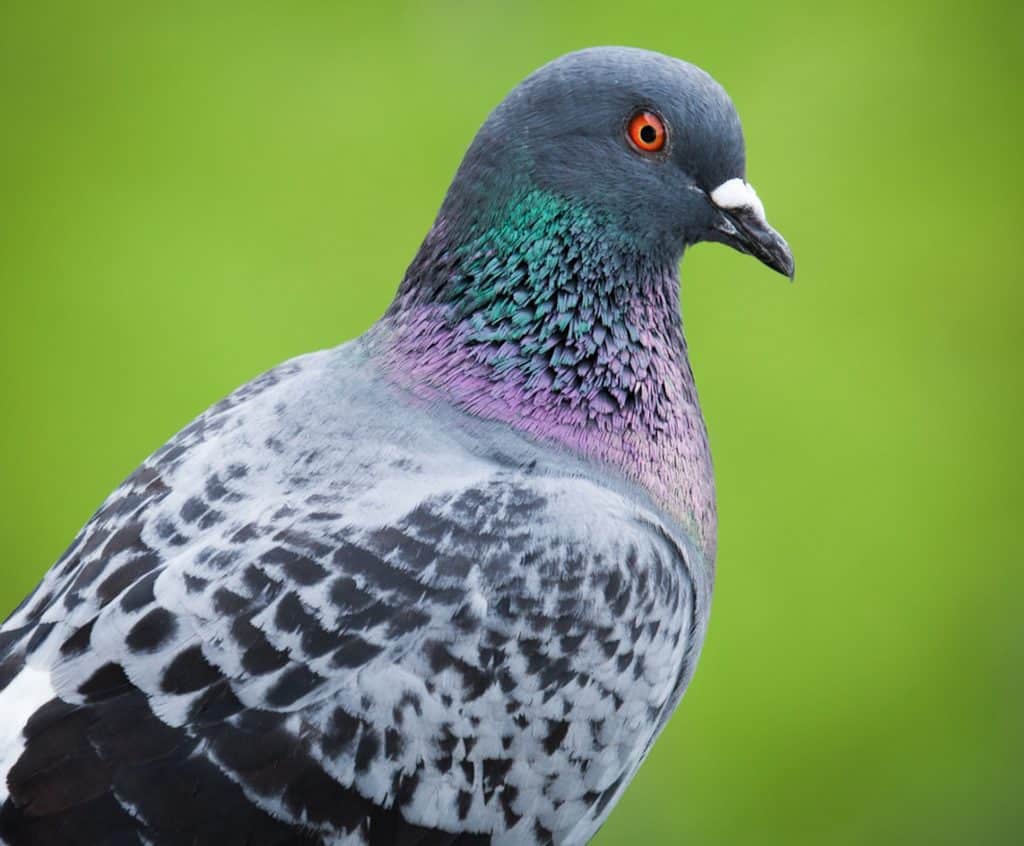
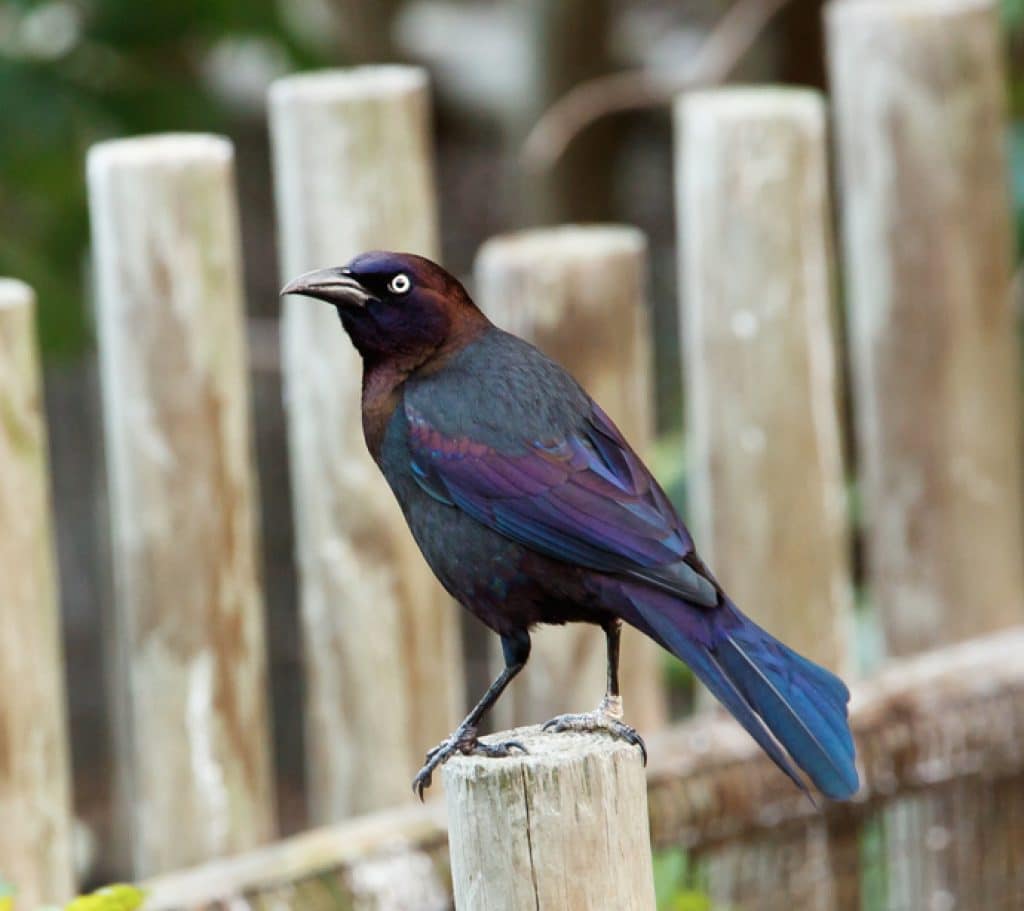
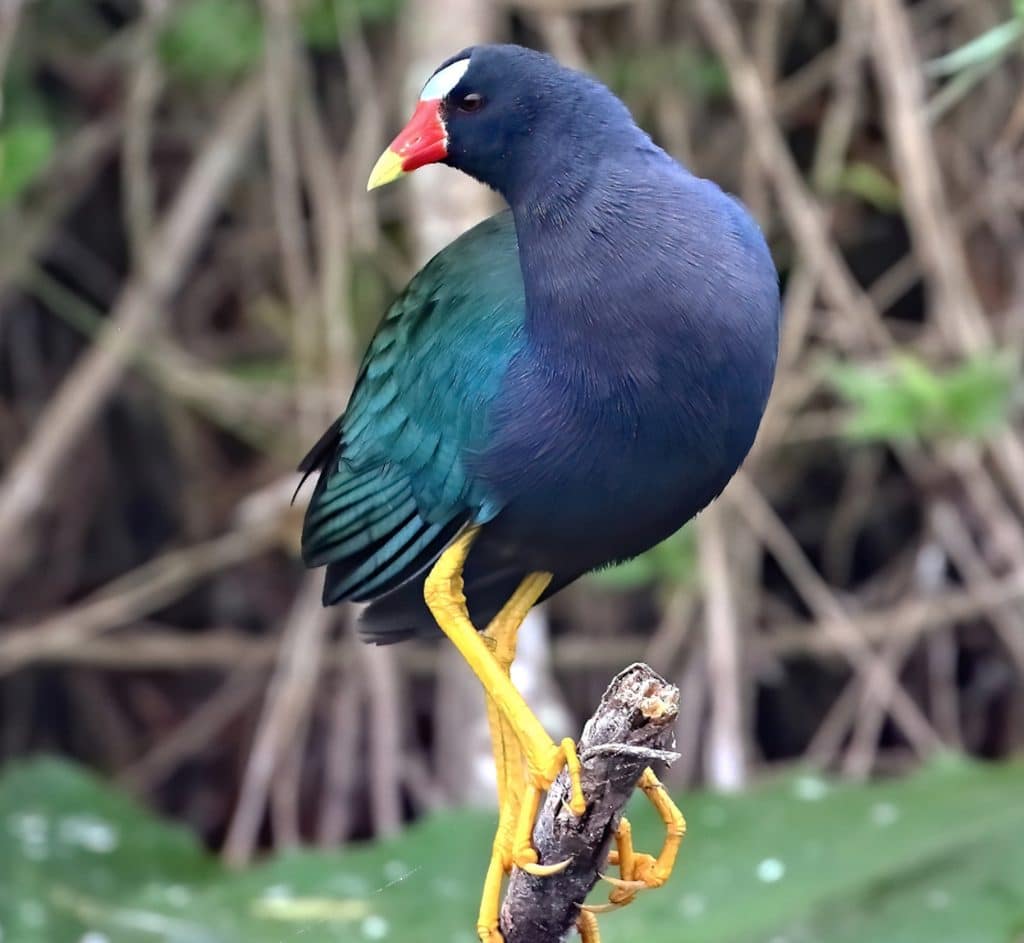
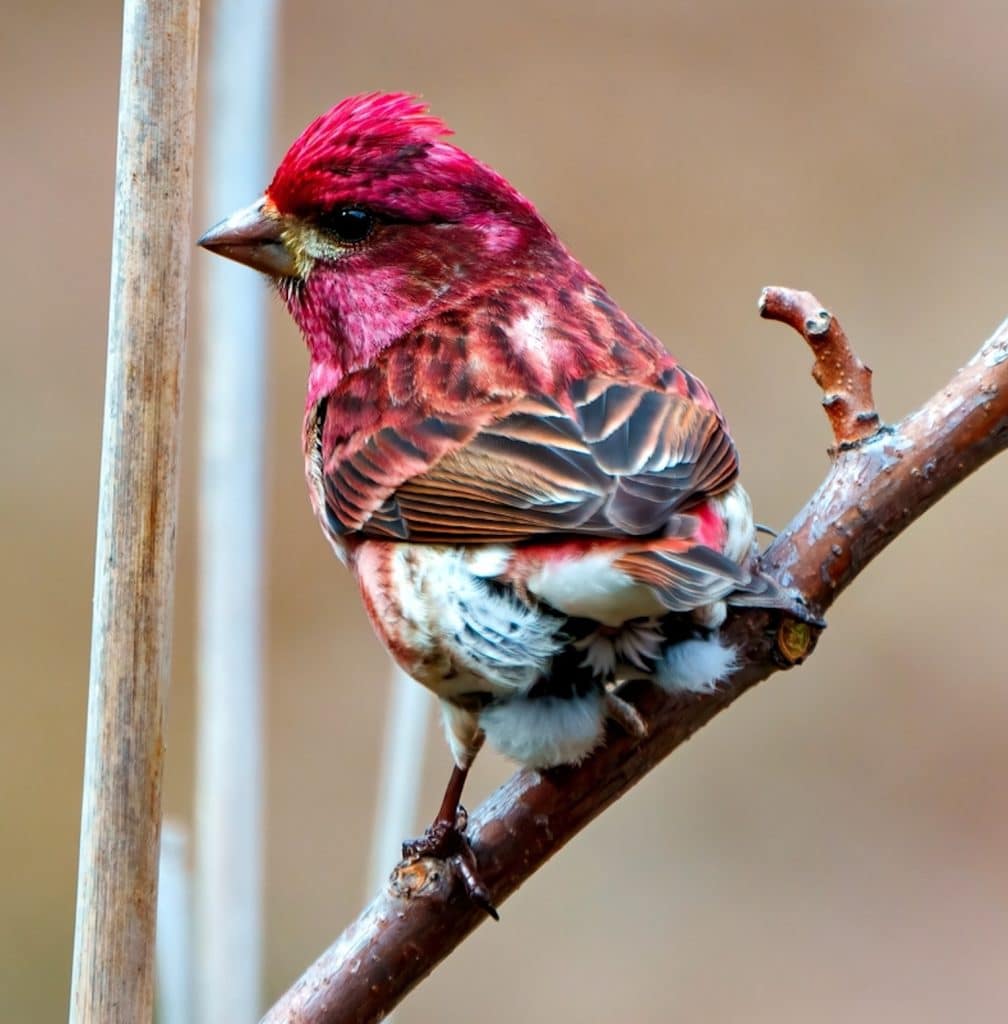
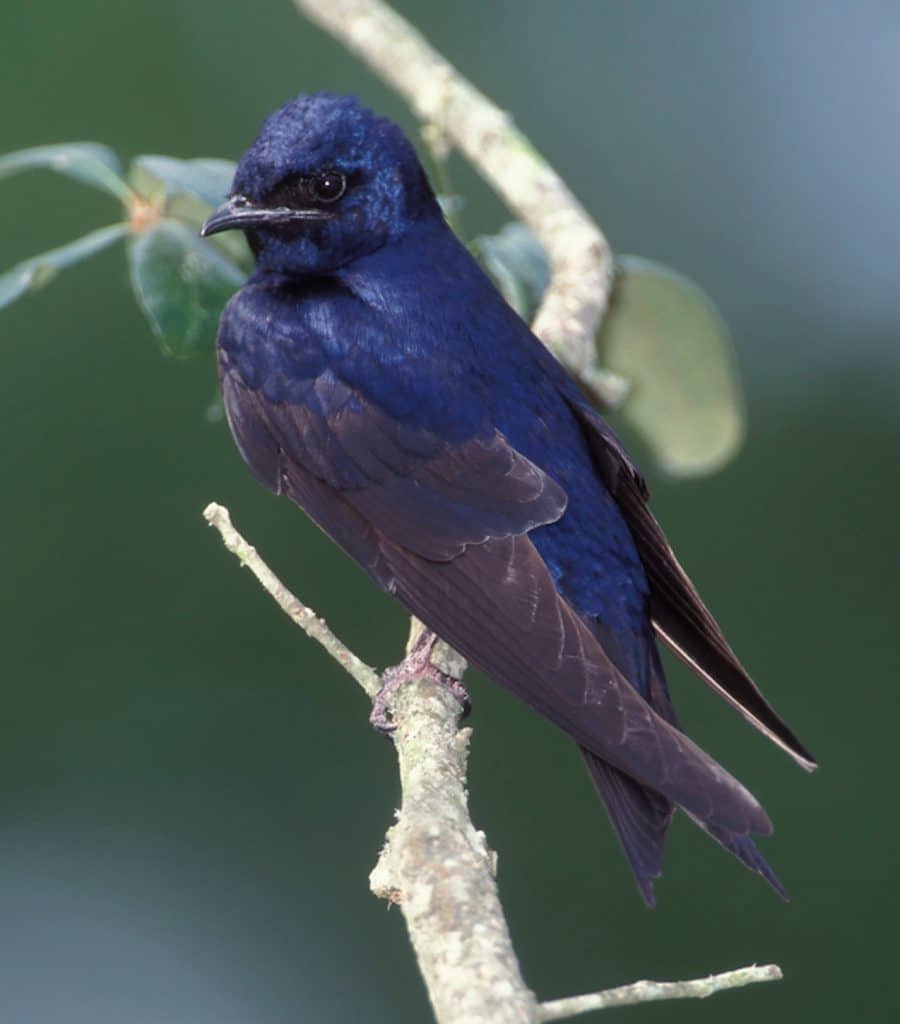
This article has two sections: a reference table of the five bird species from the US that could be considered truly purple and a section below that describes each of the birds in much greater detail. Thanks for reading, and enjoy!
Reference Table
| Bird Species & Scientific Name | Physical Description | Preferred Habitat | Geographic Location(s) |
|---|---|---|---|
| Purple Martin (Progne subis) | Largest North American swallow; males are dark, iridescent purple, females lighter with some purple on the upper parts. | Open areas near water; often nest in birdhouses or natural cavities. | Widespread in the eastern U.S. for breeding; winters in South America. |
| Purple Finch (Haemorhous purpureus) | Males are raspberry red to purple on the head and back, with more subdued hues on the rest; females are brown with bold streaks. | Coniferous and mixed forests, also visit bird feeders in suburban areas. | Northeastern and western United States, particularly in the Pacific Northwest and around the Great Lakes. |
| Purple Gallinule (Porphyrio martinicus) | Vibrant purple-blue with a green back, red and yellow bill, and long yellow legs. | Freshwater wetlands with abundant vegetation. | Southeastern U.S., especially in Florida and along the Gulf Coast; less common inland. |
| Common Grackle (Quiscalus quiscula) | Black with an iridescent purple head and body in the right light; long tail and a strong bill. | Varied; including farmlands, suburban areas, and open woodlands. | Throughout the eastern and central United States, extending into parts of the West during breeding season. |
| Rock Pigeon (Columba livia) | Wild types have iridescent purple and green necks, though coloration can vary widely due to feral populations. | Urban areas, farmlands, cliffs. | Throughout the United States in urban and rural settings; originally introduced from Europe. |
1. The Purple Martin
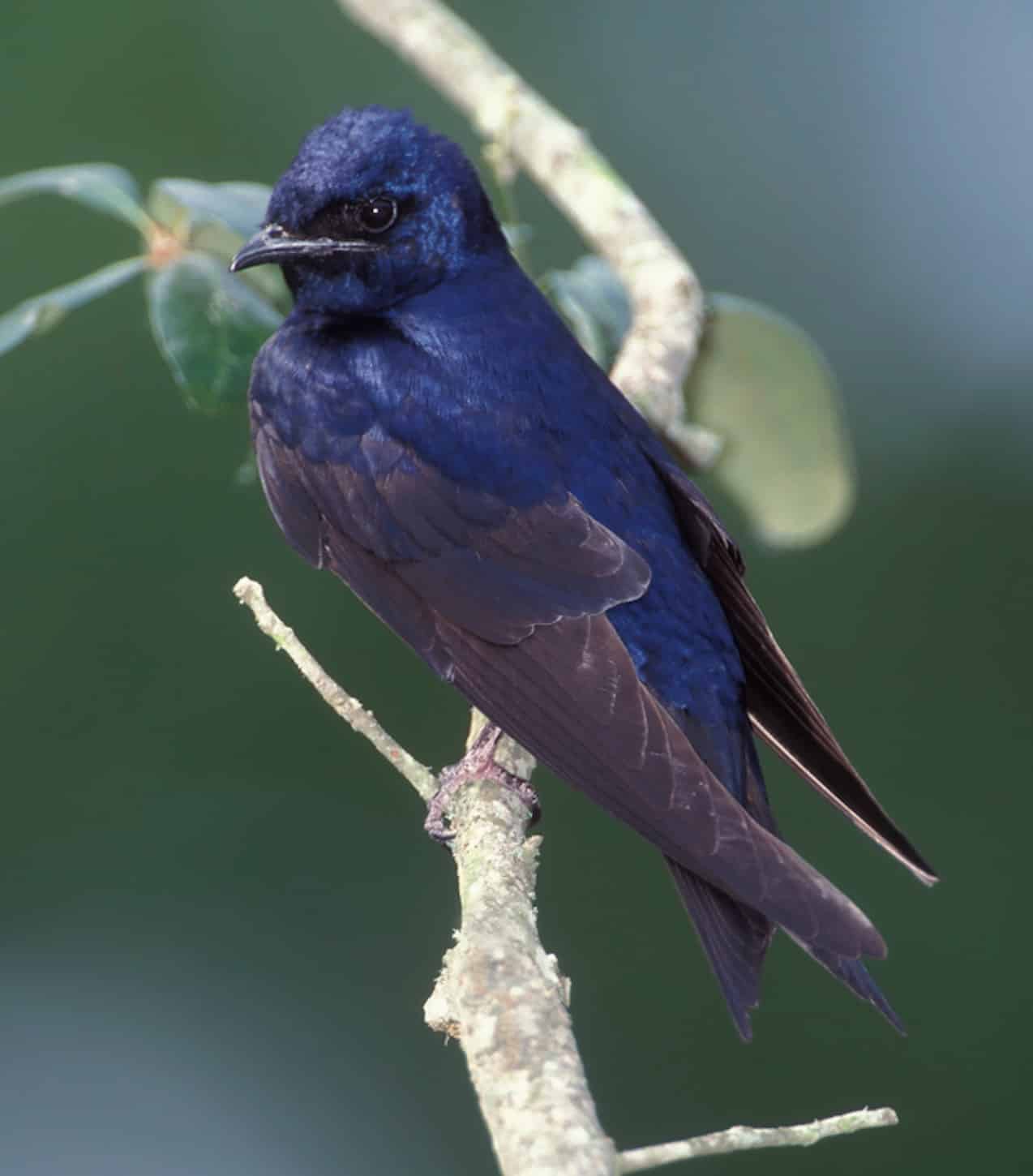
The Purple Martin (Progne subis) is the largest North American swallow, known for its vibrant plumage and aerial acrobatics. These birds are celebrated for their insect-eating habits, making them a favorite among gardeners and outdoor enthusiasts. Let’s delve into the fascinating world of the Purple Martin:
Identification
- Size and Shape: Purple Martins are large swallows with broad, pointed wings and a slightly forked tail. They have a streamlined body ideal for their acrobatic flight patterns.
- Color Pattern: Adult males are iridescent dark blue or purple all over, while females and juveniles are duller with lighter underparts. The glossy sheen of their feathers can appear black under certain lighting conditions.
Behavior
- Social and Gregarious: These birds are extremely social, often nesting in colonies that can number in the hundreds. Their flight is fast and fluid, and they can be seen swooping through the air to catch insects.
- Vocalizations: Purple Martins have a distinctive, rich, and gurgling song, and their calls are a sharp “tchew-wew.” Their vocalizations add to the lively atmosphere of their nesting sites.
- Feeding: They feed on a wide variety of flying insects, including flies, beetles, and moths. Purple Martins capture their prey mid-air in spectacular displays of agility.
Habitat
- Nesting Sites: Historically, Purple Martins nested in natural cavities, but they now almost exclusively use man-made structures provided by enthusiasts across eastern North America. These include specially designed martin houses and gourd-style homes placed in open areas.
- Migration: Purple Martins are migratory birds. They spend the breeding season in North America and then travel to South America for the winter. Their migration patterns are a focus of study and fascination among bird watchers.
Conservation Status
- Concerns and Conservation: While Purple Martins are not currently endangered, their reliance on human-provided nesting sites has raised concerns about their long-term sustainability. Conservation efforts focus on providing and maintaining suitable habitats, as well as monitoring population trends.
Tips for Watching
- Providing Homes: Erecting a Purple Martin house or gourd rack in an open area can attract colonies. It’s important to maintain these structures to ensure they remain safe and inviting for the birds.
- Observation: Watching Purple Martins is best done near their colonies, where you can observe their social interactions and feeding behaviors. Early morning and late afternoon are particularly active times.
- Community Involvement: Many bird enthusiasts participate in local Purple Martin conservation groups, offering opportunities to learn more and get involved in protecting these magnificent birds.
Purple Martins bring beauty and vitality to their environments, captivating bird watchers with their aerial prowess and social nature. Their presence is a reminder of the intricate relationships between species and the importance of conservation efforts to sustain our shared world.
2. Purple Finch
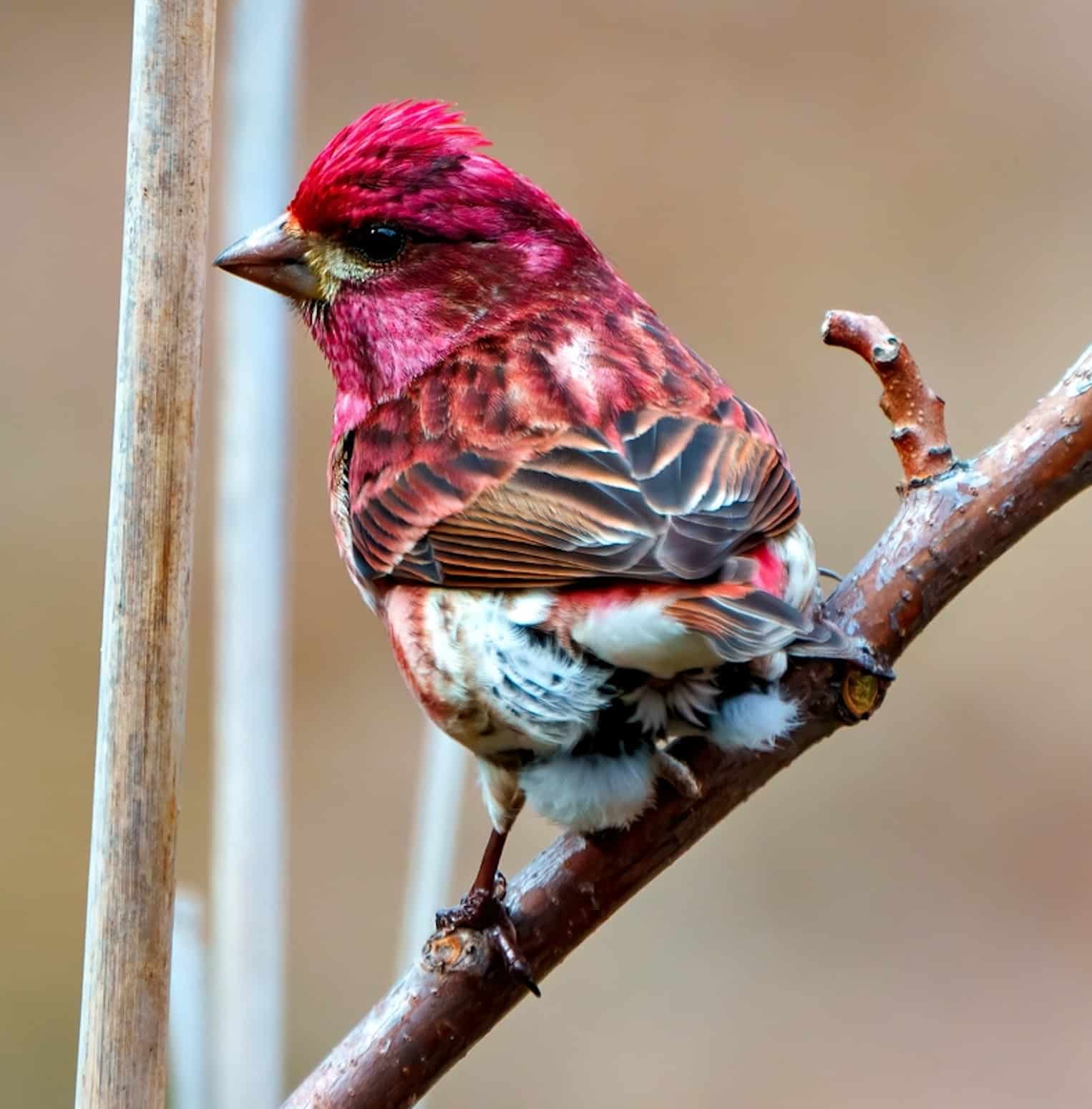
The Purple Finch (Haemorhous purpureus) is a striking bird known for its vibrant coloration and melodious song. Often confused with the House Finch, the Purple Finch carries its own unique charm and characteristics. Let’s take a closer look at this beautiful bird:
Identification
- Size and Shape: Purple Finches are small to medium-sized finches with a chunky build and a short, notched tail. They have a relatively large head and a robust beak designed for cracking seeds.
- Color Pattern: Males are most notable for their raspberry red plumage, which covers their head, breast, and back. Females and juveniles are more subdued, with a brown and white streaked appearance. The key distinguishing feature is the male’s vibrant red coloring, which contrasts with the House Finch’s more orange hue.
Behavior
- Feeding Habits: These finches are primarily seed eaters, but they also enjoy fruits and occasionally insects. They can be found foraging on the ground or in trees and shrubs. At feeders, they are often observed asserting dominance, even over larger bird species.
- Vocalizations: The Purple Finch’s song is a rich, melodious warble, interspersed with short, sharp notes. Their song is considered one of the most beautiful among North American finches and is a delight to bird watchers and listeners.
- Social Behavior: Outside of the breeding season, Purple Finches can be found in flocks. Their social structure at feeders and in the wild is an interesting aspect of their behavior to observe.
Habitat
- Natural Settings: Purple Finches inhabit coniferous and mixed forests, as well as suburban and rural gardens. They are found across Canada, the northeastern and western United States, and migrate to the southeastern U.S. for winter.
- Nesting: They nest in trees, often choosing conifers. Their nests are made from twigs, grass, and other plant materials, and are typically placed at a moderate height from the ground.
Conservation Status
- Stable but Watchful: The Purple Finch population has faced challenges due to habitat loss and competition from the closely related House Finch. However, they are not currently considered endangered, and efforts to monitor their population continue.
Tips for Watching
- Attracting to Feeders: To attract Purple Finches, provide sunflower seeds or a mix of seeds in tube or platform feeders. They are particularly fond of black oil sunflower seeds.
- Observation: Observing these finches in natural settings provides insight into their feeding and social behaviors. In areas where they are common, their vibrant colors and melodious songs make them easy to enjoy.
- Distinguishing from House Finches: Pay close attention to the color and the head shape. Purple Finches have a more rounded head and their red color extends to the back, whereas House Finches have a flatter head and their red color is mostly on the chest and head.
The Purple Finch enriches its habitat with beauty and song, offering bird watchers and enthusiasts a delightful spectacle. Their presence in the wild and at feeders brings a splash of color and a chorus of songs to their surroundings, making them a beloved bird across their range.
3. Purple Gallinule
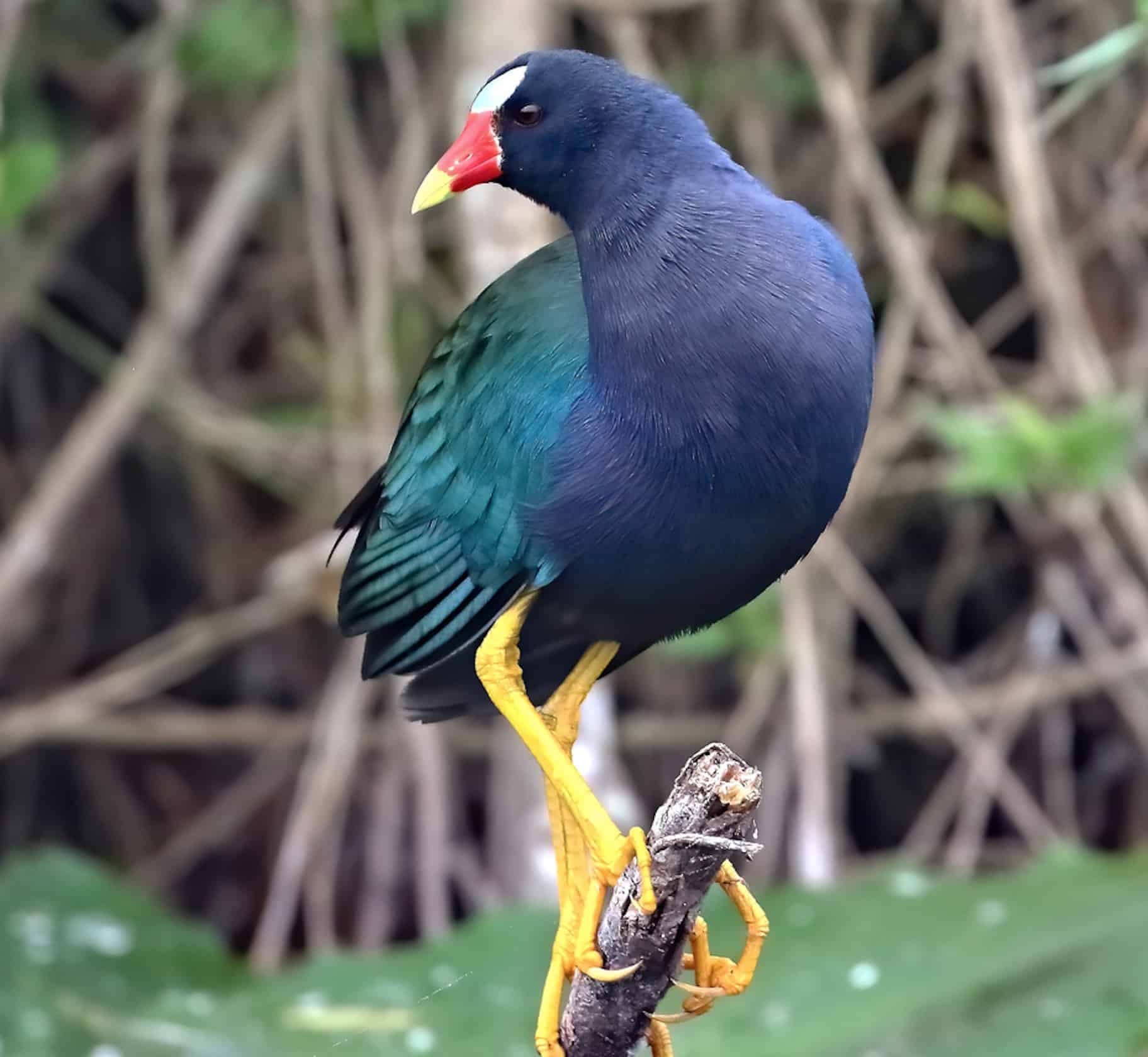
The Purple Gallinule (Porphyrio martinicus) is a vibrantly colored bird that inhabits the wetlands of the southeastern United States, Central America, and South America. This bird’s striking appearance and unique behaviors make it a fascinating subject for bird watchers and nature enthusiasts alike. Let’s dive into the world of the Purple Gallinule:
Identification
- Size and Shape: Purple Gallinules are medium-sized birds with a plump body, short tail, and long yellow legs. They have a frontal shield (a flat, plate-like area) on their forehead, which is characteristic of the rail family.
- Color Pattern: They boast an iridescent purple-blue plumage that shines brilliantly in the sunlight, with greenish-black wings and back. Their bill is bright red with a yellow tip, and they have a pale blue forehead shield, making them one of the most colorful birds in their range.
Behavior
- Foraging Habits: Purple Gallinules are omnivores, feeding on a variety of plant materials, seeds, insects, and small aquatic creatures. They are often seen walking on floating vegetation in search of food, using their long toes to grasp and balance.
- Vocalizations: Their calls are a series of loud, croaking, and gurgling sounds that can be heard echoing through the marshes. These vocalizations play a crucial role in communication among Purple Gallinules, especially during the breeding season.
- Swimming and Flying: Although they are more often seen walking on vegetation or wading, Purple Gallinules can swim well using their lobed feet and are capable fliers, though they usually fly only short distances.
Habitat
- Wetland Dwellers: Purple Gallinules prefer freshwater marshes, swamps, and wetlands with dense aquatic vegetation. These habitats provide them with ample food and cover from predators.
- Range and Migration: Their range extends from the southeastern United States through the Caribbean to Central and South America. Some populations in the northern part of their range migrate to warmer areas for the winter.
Conservation Status
- Monitoring Needed: While not currently considered endangered, Purple Gallinules depend heavily on wetland habitats, which are threatened by development, pollution, and climate change. Conservation efforts to preserve and restore wetland habitats are vital for their survival.
Tips for Watching
- Best Times and Places: To observe Purple Gallinules, visit freshwater wetlands and marshes in their range, especially during the morning or late afternoon when they are most active.
- Patience is Key: These birds can be elusive, often hiding in dense vegetation. Watching quietly and patiently at the edge of marshes can reward you with sightings.
- Look for Movement: Keep an eye on floating vegetation for any movement, as Purple Gallinules may be walking on the plants or foraging among them.
The Purple Gallinule, with its striking colors and unique lifestyle, is a testament to the beauty and diversity of wetland ecosystems. Observing these birds in their natural habitat offers a glimpse into the complex and interconnected world of freshwater marshes and the importance of conserving these vital environments.
4. Common Grackle
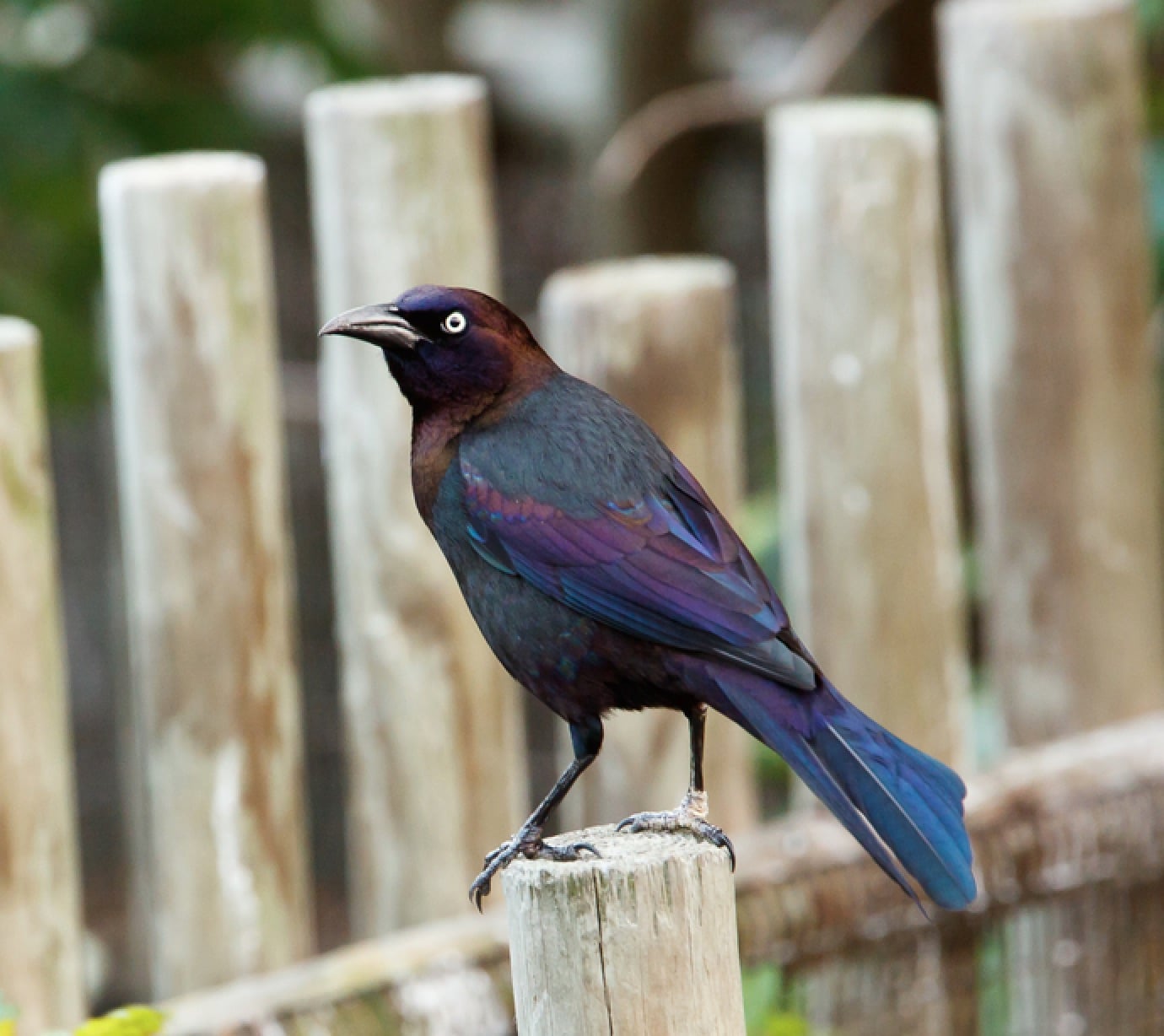
The Common Grackle (Quiscalus quiscula) is a bird that’s both admired and maligned, depending on one’s perspective. Known for its iridescent plumage and gregarious nature, this bird is a common sight across much of North America. Let’s explore some key aspects of the Common Grackle:
Identification
- Size and Shape: Common Grackles are medium to large birds with a long body, a distinctive tail that is keel-shaped or V-shaped, and a strong, straight bill. They have a broad shoulder and a flat head which gives them a striking silhouette.
- Color Pattern: Males have a glossy black plumage with an iridescent sheen that can appear purple, blue, or green in the light. Females are slightly less glossy than males. Their eyes are a striking yellow or gold, adding to their unique appearance.
Behavior
- Foraging Habits: These birds are omnivorous, feeding on a wide variety of foods including insects, seeds, grains, fruits, and even small mammals and fish. They often forage on the ground, walking with a distinctive swagger.
- Vocalizations: Common Grackles are known for their wide range of vocalizations, from sharp, squeaky calls to more melodious tones. Their song can be described as a harsh, scratchy jumble of sounds, which is less musical than those of many other birds.
- Social Behavior: They are highly social birds, often found in large flocks, especially during migration or when roosting at night. These flocks can include thousands of birds and create impressive sights in the sky.
Habitat
- Versatile Dwellers: Common Grackles adapt well to various habitats, including open woodlands, fields, parks, and urban areas. They are particularly common in agricultural areas and around human habitation, where they can find plentiful food and nesting sites.
- Range: Their range covers much of North America, from the Rocky Mountains eastward to the Atlantic Coast, and from Canada down into the southern United States.
Conservation Status
- Abundant but Declining: While Common Grackles are still abundant, their populations have been experiencing significant declines over the past few decades due to habitat loss and other factors. However, they are not currently considered threatened or endangered.
Tips for Watching
- Observe Flocks: To see Common Grackles, look for large flocks in open fields, parks, or wetlands, especially during migration periods in the spring and fall.
- Listen for Their Calls: Their distinctive vocalizations can be a helpful guide to locating them, especially in areas where they are roosting or foraging in large numbers.
- Backyard Birding: Attracting them to your yard can be as simple as providing bird feeders with mixed seeds or suet. However, be aware that their large numbers can sometimes deter other bird species.
The Common Grackle offers an excellent opportunity to observe and appreciate the complexities of avian social structures and adaptability. Despite their common status, these birds possess unique traits and behaviors that can fascinate any bird watcher or nature enthusiast.
5. Rock Pigeon (Columba livia)
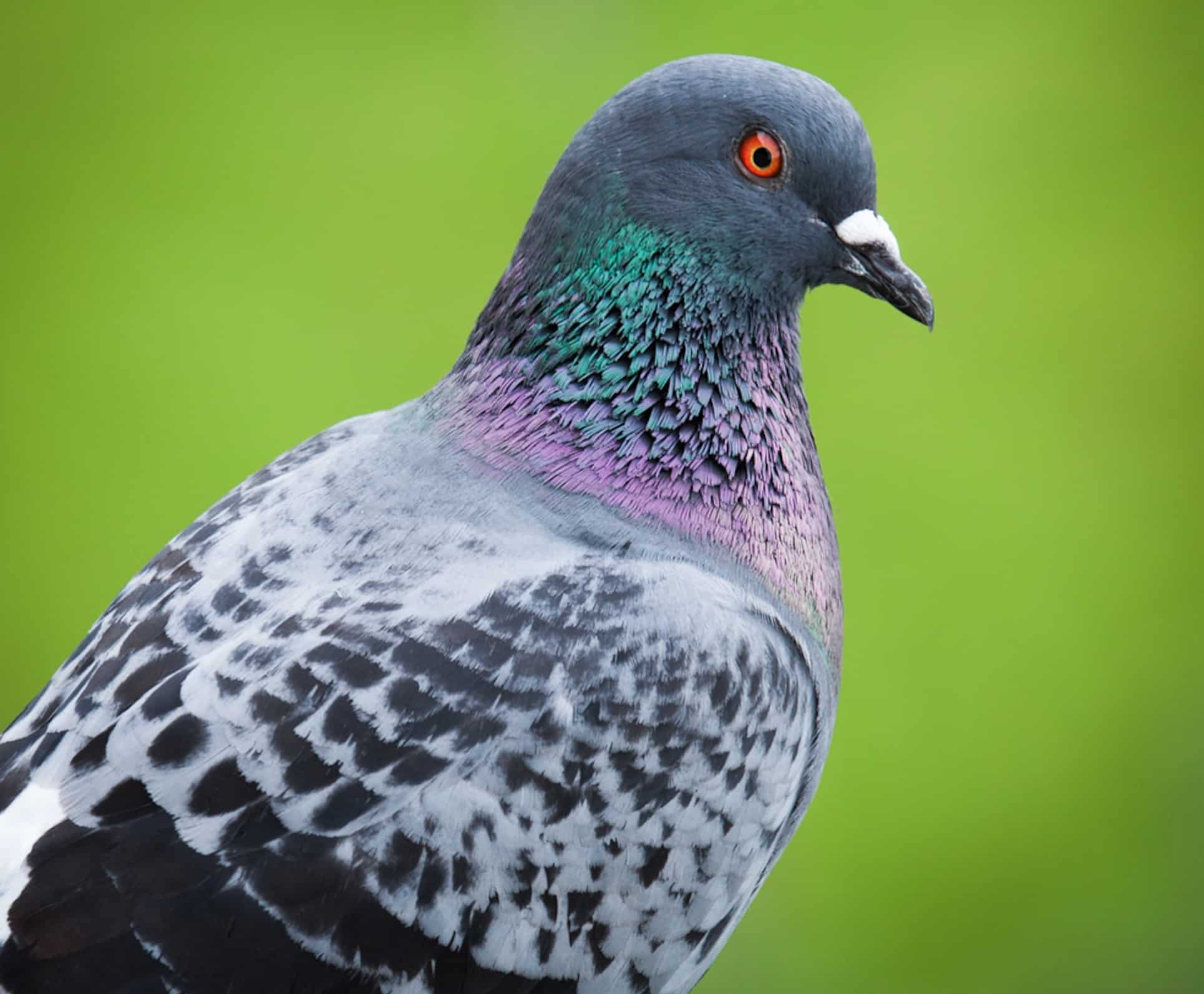
The Rock Pigeon (Columba livia) is a bird so familiar that it often goes unnoticed, yet its adaptability and history with humans are truly remarkable. Originating from the wild rock doves of Europe, North Africa, and South Asia, these birds have become one of the most ubiquitous urban wildlife species around the globe. Let’s take a closer look at the Rock Pigeon:
Identification
- Size and Shape: Rock Pigeons are stout-bodied birds with short necks and short, slender bills with a fleshy cere. They have a characteristic silhouette, with a rounded head and a robust body.
- Color Pattern: While typically blue-gray with a white lower back, two black bars on each wing, a broad dark tail, and iridescent neck feathers, Rock Pigeons can come in a wide range of colors due to selective breeding by humans. These colors include variations of white, black, brown, and even red.
Behavior
- Feeding Habits: They are ground feeders that eat a diet of seeds, grains, and occasionally insects. In urban areas, they also consume bread crumbs, popcorn, and other food provided by humans or found in trash bins.
- Vocalizations: Rock Pigeons make soft, cooing calls that can have a soothing effect. Their cooing is often associated with their social interactions and is used to attract mates.
- Flocking and Flying: They are highly social and often found in large flocks. Their flight is fast and direct, with regular wing beats and an occasional sharp flick of the wings.
Habitat
- Urban to Wild: While they thrive in cities and towns where they live in close association with humans, Rock Pigeons can also be found in natural cliff faces and rocky outcrops, reflecting their wild ancestry. They nest on building ledges, bridges, and other structures in urban environments.
- Worldwide Distribution: Originally native to Eurasia and North Africa, they have been introduced to cities around the world, making them one of the most widespread bird species.
Conservation Status
- Abundant: Rock Pigeons are not considered a conservation concern due to their vast numbers and successful adaptation to urban environments. However, their presence in large numbers can sometimes be seen as a nuisance or health concern in cities.
Tips for Watching
- Urban Birding: Observing Rock Pigeons can provide insights into bird behavior and adaptation. Watching how they interact with their environment and each other can be fascinating.
- Feeding Behavior: Offering seeds in parks or urban squares can attract them for closer observation. Notice the variety of colorations and social dynamics as they feed.
- Nesting and Fledging: In cities, look for their nests under bridges or on building ledges. Observing a pair’s nesting behavior and the growth of their chicks can offer a glimpse into the cycle of life right in our urban centers.
Despite their commonplace status, Rock Pigeons have a rich history of association with humans, serving as symbols, messengers, and even participants in competitive racing. Their presence in urban landscapes offers an easily accessible way to connect with nature and observe the complexities of avian life up close.